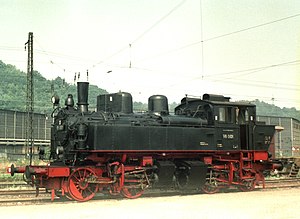Saxon I TV
| I TV DR series 98.0 |
|
|---|---|
|
98 001 on August 27, 1983 in Freital-Hainsberg
|
|
| Numbering: | 98 001 - 98 015 |
| Number: | 19th |
| Manufacturer: | Saxon machine factory , Chemnitz |
| Year of construction (s): | 1910 to 1914 |
| Retirement: | until 1968 |
| Type : | B'B 'n4vt |
| Gauge : | 1435 mm ( standard gauge ) |
| Length over buffers: | 11,624 mm |
| Empty mass: | 47.8-50.4 t |
| Service mass: | 59.0-62.0 t |
| Friction mass: | 60.5 t |
| Wheel set mass : | 15.4 t |
| Top speed: | 50 km / h |
| Indexed performance : | 540 PSi |
| Driving wheel diameter: | 1,260 mm |
| Control type : | Heusinger |
| Number of cylinders: | 4th |
| HD cylinder diameter: | 360 mm |
| LP cylinder diameter: | 570 mm |
| Piston stroke: | 630 mm |
| Boiler overpressure: | 13 bar |
| Number of heating pipes: | 199 |
| Heating pipe length: | 3,700 mm |
| Grate area: | 1.60 m² |
| Radiant heating surface: | 6.8 m² |
| Tubular heating surface: | 92.5 m² |
| Evaporation heating surface: | 99.28 m² |
| Water supply: | 5.0 m² |
| Fuel supply: | 2.2 t |
| Brake: | Westinghouse |
As a generic IT designated Royal Saxon State Railways the tank locomotives of the type Meyer , which specifically for the curvature rich Windbergbahn were procured. The Deutsche Reichsbahn assigned the locomotives to the 98.0 series in 1925 .
history

Near Dresden , the Kgl. Saxon. State railways with the Windbergbahn, a branch line primarily serving coal traffic, which, in addition to a steep incline, also had a curve radius of only 85 meters. At the turn of the century, the performance of the previously used locomotives of type VII T was no longer sufficient. The reasons for this were the onset of excursion traffic as well as increasing transport volumes in coal transport. Between 1910 and 1914, the Sächsische Maschinenfabrik delivered a total of 19 locomotives in 3 lots and a single Meyer type, which were largely similar in their design to the tried and tested narrow-gauge locomotives of the IV K type . The construction lots differed in terms of their service weights and external design. They were popularly known as "Windberglok" or "Cross spider".
Three copies were lost in the First World War ; The Deutsche Reichsbahn took over the remaining 15 locomotives in 1920 and gave them the numbers 98 001 to 98 015. Like all locomotives of the 98 series , the machines were thus classified as local railroad locomotives .
In 1940 the Reichsbahn took over another locomotive of this type that had been delivered to the Oberhohndorf-Reinsdorfer coal railway and gave it the road number 98 015 with a second crew.
All machines survived the Second World War . Two locomotives were badly damaged in the air raid on February 13, 1945, but were rebuilt. They continued to be used on their main line in passenger and freight traffic. Between 1952 and 1962 they were used in double traction in front of uranium ore block trains to Dresden-Gittersee . The trains consisted of 10 wagons with a loading weight of 20 tons. The 8 remaining locomotives transported 560,000 uranium ore to Gittersee every year. It was only with the locomotives of the DR series V 60 (later series 106, now 346) with wheel flange lubrication that the locomotives could be replaced on the winding route at the end of the 1960s. In 1968 the last copy of this series was taken out of service.
The 98 001 (ex I TV 1394) has been preserved to this day and is part of the holdings of the Dresden Transport Museum . It is currently on loan at the Industrial Museum in Chemnitz .
technical features
The locomotives had a long boiler made from two sections. The standing kettle was designed with a semicircular ceiling of the Crampton design. Two non- suction Friedmann injectors were used to feed the boiler . From 1914, those of the winemaker type were also used.
The steam engine was designed as a four-cylinder compound drive with Heusinger control and flat slide valves. The smaller high-pressure cylinders were on the front, the larger low-pressure cylinders on the rear bogie. The bogies were connected by a coupling iron in order to reduce any counter-rotating movements.
The water supply was housed in containers on the side, the coal in a box behind the driver's cab.
The locomotives were factory-fitted with a Westinghouse air brake, supplemented by a throw lever brake. As special equipment, they were provided with a Latowski type of steam flare.
literature
- Fritz Näbrich, Günter Meyer, Reiner Preuß: Lokomotivarchiv Sachsen 2. transpress VEB Verlag für Verkehrwesen, Berlin 1983, or Alba publication Alf Teloeken GmbH + Co KG, Düsseldorf, ISBN 3-87094-096-4 .
- Erich Preuß , Reiner Preuß : Saxon State Railways . transpress Verlagsgesellschaft, Berlin 1991, ISBN 3-344-70700-0 .
- Rainer Scheffler: About the "cross spiders" of the Windbergbahn. in: Modelleisenbahner 30 (1981) 3, pp. 75/76.
- Jürgen Schubert: The Windbergbahn . transpress VEB Verlag for Transport, Berlin 1982, or alba Verlag, Düsseldorf, ISBN 3-87094-202-9 .
- Günther Reiche: Richard Hartmann and his locomotives . Oberbaumverlag, Chemnitz 1998, ISBN 3-928254-56-1 .


